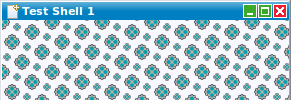RAP 1.1 M3 - New and Noteworthy
Here are some of the more noteworthy things that will be available in the milestone build M3 (April 7, 2008)which is now available for download.
This list shows all bugs that were fixed during this milestone.
RWT
| UI Styling API |
Support for background images
The methods Control#get/setBackgroundImage() allow to
set background images on almost all controls.

Support for transparency
Semi-transparent Shells
| |
| Theming Variants |
It is now possible to define variants of widget types that can be
styled separately. As an example, an application that uses PUSH
buttons in a special side bar can define a variant "side-button" and
apply a different styling to these buttons. This styling only
applies to the buttons belonging to the variant and does not
affect any other PUSH buttons in the application.
The variant is set using the widget user data
( | |
| ISettingStore |
There is a new subsystem in RWT that allows to persist user-specific
settings:
It is also possible to load specific settings independently from cookies:
Note that the setting store subsystem is used by the new ScopedPreferenceStore implementation of the workbench.
See API documentation for more information. | |
| Mouse Events |
RWT now has support for MouseEvents. Calling
addMouseListener on a Control will notify you about
mouseUp, mouseDown and
mouseDoubleClick events.
Please be aware that, apart from the API, there are still some limitations that will be addressed during the next development cycle. |
Workbench
| Support for activities |
The RAP Workbench now supports the org.eclipse.ui.activities
and org.eclipse.ui.activitySupport extension points. You
can control the visibility of views, editors, perspectives, menu and
toolbar items using activities and trigger points. See the extension
point documentation for details.
| |
| RAP HttpContext |
The RAP servlet now uses its own HttpContext implementation. This
allows other servlets to map to that context too. This enables the
possibility to share the same session instances between those
servlets and the RAP servlet for data exchange.
| |
| ScopedPreferenceStore |
The RAP workbench provides now
org.eclipse.ui.preferences.ScopedPreferenceStore that
allows to read and set user-specific preferences using the
preference mechanism provided by org.eclipse.core.runtime.
The base of the storage mechanism is a subsystem of RWT represented
by org.eclipse.rwt.service.ISettingStore.
The session aware
org.eclipse.jface.preference.IPreferenceStore can be
retrieved using the method
org.eclipse.ui.plugin.AbstractUIPlugin.getPreferenceStore.
See API documentation for more information. | |
| Import-/Exportwizards |
RAP supports now Import- and Exportwizards by providing
the extension points importWizards and
exportWizards. See also ActionFactory.IMPORT
and ActionFactory.EXPORT for opening the import-/export
wizard.
|
The above features are just the ones that are new since the last milestone build. Summaries for earlier builds:








